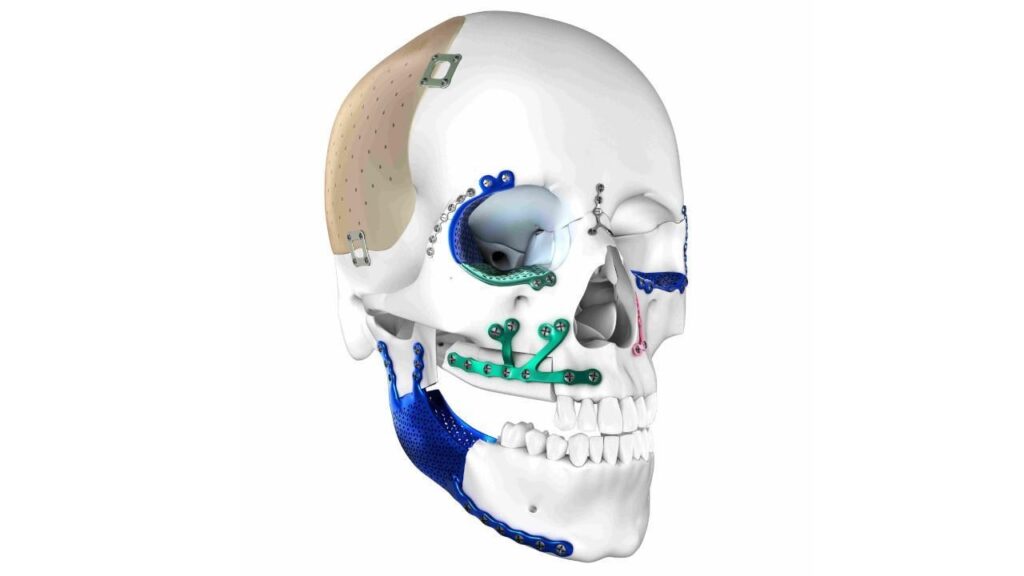The global craniomaxillofacial implants market is witnessing remarkable growth, driven by the increasing prevalence of facial injuries, trauma, and cranial defects. As of 2023, the market size was valued at approximately USD 2.3 billion, with expectations of robust expansion in the coming years. According to industry projections, the market is expected to grow at a compound annual growth rate (CAGR) of 7.13%, reaching an estimated USD 4.3 billion by 2032. This article delves into the dynamics of the craniomaxillofacial implants market, key players, segments, and future opportunities, while also exploring the impact of the COVID-19 pandemic and answering some frequently asked questions.
What Are Craniomaxillofacial Implants?
Craniomaxillofacial implants are medical devices used to repair or replace bone structures in the face and skull, primarily following trauma, congenital defects, or surgical procedures. These implants are crucial for reconstructive surgeries, restoring both the functional and aesthetic integrity of the face. The implants are typically made from materials like titanium, stainless steel, or bioabsorbable materials, and they serve patients suffering from conditions such as:
- Facial fractures (e.g., orbital, maxillary, mandibular)
- Cranial defects (e.g., skull fractures or deformities)
- Congenital malformations
- Post-surgical reconstructions (e.g., from tumor excision)
Market Drivers
Several factors are contributing to the growth of the craniomaxillofacial implants market:
1. Rising Incidence of Facial Injuries and Trauma
Accidents, physical confrontations, and sports injuries are among the leading causes of facial trauma. According to the World Health Organization (WHO), millions of people worldwide suffer from facial fractures or injuries every year. These injuries often require advanced medical intervention, including craniomaxillofacial implants.
2. Growing Geriatric Population
The ageing population globally is increasing, and with it, the prevalence of age-related conditions such as osteoporosis, which makes bones more fragile and prone to fractures. Elderly patients, particularly those over 60, are more susceptible to cranial and facial injuries, creating a greater demand for craniomaxillofacial implants.
3. Advancements in Implant Materials and Technology
Technological advancements in 3D printing, bioresorbable materials, and computer-aided design (CAD) have significantly improved the quality and customization of craniomaxillofacial implants. These innovations have made surgeries more precise and recovery times shorter, further driving the adoption of these implants in the healthcare sector.
4. Increasing Awareness and Acceptance of Facial Reconstruction
With the rise in media coverage of facial reconstruction surgeries, there is greater awareness and acceptance of craniomaxillofacial implant procedures. This has contributed to a surge in demand for both functional and aesthetic procedures, particularly among patients seeking to correct congenital deformities or post-traumatic facial issues.
5. Improved Healthcare Infrastructure in Developing Economies
Countries in Asia-Pacific, the Middle East, and Latin America are investing heavily in improving healthcare infrastructure. As a result, the demand for medical devices, including craniomaxillofacial implants, is growing as healthcare access expands.
Market Segmentation
The craniomaxillofacial implants market can be segmented based on type, material, application, and region.
1. By Type
- Fixation Devices: These are used to stabilize fractures and broken bones in the face and skull, including plates, screws, and meshes.
- Bone Grafts: Used to repair bone defects or to encourage new bone growth.
- Distraction Devices: Used to lengthen bones gradually and restore facial structure.
2. By Material
- Titanium: The most commonly used material due to its strength, biocompatibility, and resistance to corrosion.
- Stainless Steel: A more cost-effective option, used in some lower-risk applications.
- Polymer-Based Materials: Bioresorbable materials that can be absorbed by the body over time.
3. By Application
- Cranial and Facial Fractures: Including fractures of the skull, jaw, cheekbones, and facial bones.
- Cranial Defects: For patients with deformities due to congenital conditions or trauma.
- Orthognathic Surgery: For jaw reconstruction in patients with malocclusions or congenital defects.
4. By Region
- North America: Dominates the market, driven by advanced healthcare systems and high demand for cosmetic and reconstructive surgeries.
- Europe: Expected to grow steadily due to the increasing geriatric population and well-established healthcare infrastructure.
- Asia-Pacific: Projected to experience the fastest growth, driven by increasing healthcare investments and a large patient population.
- Latin America and Middle East & Africa: Growing demand driven by improving healthcare access and rising awareness of facial reconstructive surgeries.
Key Market Players
The global craniomaxillofacial implants market features several key players that contribute significantly to its growth. Some of the leading companies in the market include:
1. Stryker Corporation
Stryker is a global leader in medical technology, and its craniomaxillofacial implants are widely used in both reconstructive and cosmetic procedures. The company offers a broad portfolio of products, including titanium plates, screws, and other fixation devices.
2. Medtronic PLC
Medtronic is another major player, providing innovative solutions for cranial and facial reconstruction. They focus on providing high-quality products for trauma cases and post-surgical recovery, including bone grafts and distraction devices.
3. Zimmer Biomet
Zimmer Biomet specializes in musculoskeletal healthcare and provides a variety of craniomaxillofacial implants. They offer products for both functional and aesthetic facial reconstruction.
4. KLS Martin Group
Known for its comprehensive range of craniomaxillofacial solutions, KLS Martin Group focuses on innovative products such as titanium plates, screws, and custom implants.
5. Johnson & Johnson (Ethicon)
Ethicon, part of Johnson & Johnson, offers a range of surgical instruments and implants, including those for craniomaxillofacial procedures. The company is renowned for its commitment to safety and quality.
COVID-19 Impact on the Craniomaxillofacial Implants Market
The COVID-19 pandemic had a significant impact on healthcare systems worldwide, including the craniomaxillofacial implants market. During the peak of the pandemic, many elective surgeries, including reconstructive facial surgeries, were postponed or canceled due to the overwhelming pressure on healthcare facilities.
However, as the world gradually recovers from the pandemic, the market is seeing a resurgence. Hospitals are resuming elective surgeries, and patients are more eager to undergo facial reconstruction procedures that were delayed during the pandemic. Additionally, the healthcare industry’s focus on enhancing patient care and safety has spurred investment in medical technologies, including craniomaxillofacial implants.
Future Trends and Opportunities
1. 3D Printing and Custom Implants
The integration of 3D printing technology is transforming the craniomaxillofacial implants market by allowing for the creation of personalized implants tailored to the patient’s anatomy. This technology is expected to reduce surgery times and improve recovery outcomes.
2. Bioabsorbable Implants
Bioabsorbable implants, which gradually dissolve in the body over time, are gaining traction. These implants eliminate the need for a second surgery to remove the device, improving patient comfort and reducing healthcare costs.
3. Minimally Invasive Procedures
There is a growing trend toward minimally invasive procedures in craniomaxillofacial surgery. Techniques such as endoscopic surgery, combined with advanced implant materials, are reducing recovery times and improving surgical outcomes.
4. Integration of Artificial Intelligence (AI)
AI technologies are becoming more common in surgical planning and post-operative care. AI can help surgeons create more accurate implant models and improve surgical precision, further enhancing patient outcomes.
FAQs
1. What are craniomaxillofacial implants used for?
Craniomaxillofacial implants are used to repair or replace bones in the face and skull due to trauma, congenital defects, or surgical procedures.
2. What materials are used in craniomaxillofacial implants?
Common materials include titanium, stainless steel, and bioresorbable polymers, each offering different benefits in terms of strength, biocompatibility, and cost.
3. How is the market expected to grow in the coming years?
The craniomaxillofacial implants market is expected to grow at a CAGR of 7.13%, reaching USD 4.3 billion by 2032.
4. What factors are driving the growth of the craniomaxillofacial implants market?
The market is primarily driven by the increasing incidence of facial injuries, aging populations, advancements in implant technology, and growing awareness of facial reconstruction.
5. What are the major challenges in the market?
Key challenges include the high cost of advanced implants, regulatory hurdles, and the potential risks associated with implant failure.


